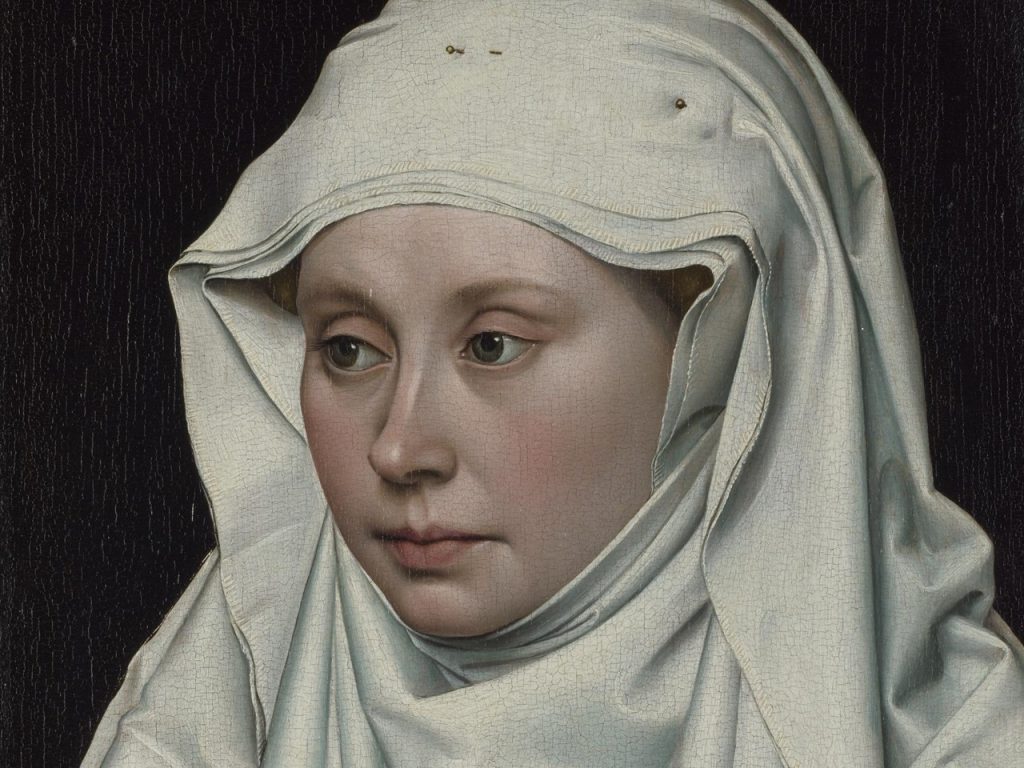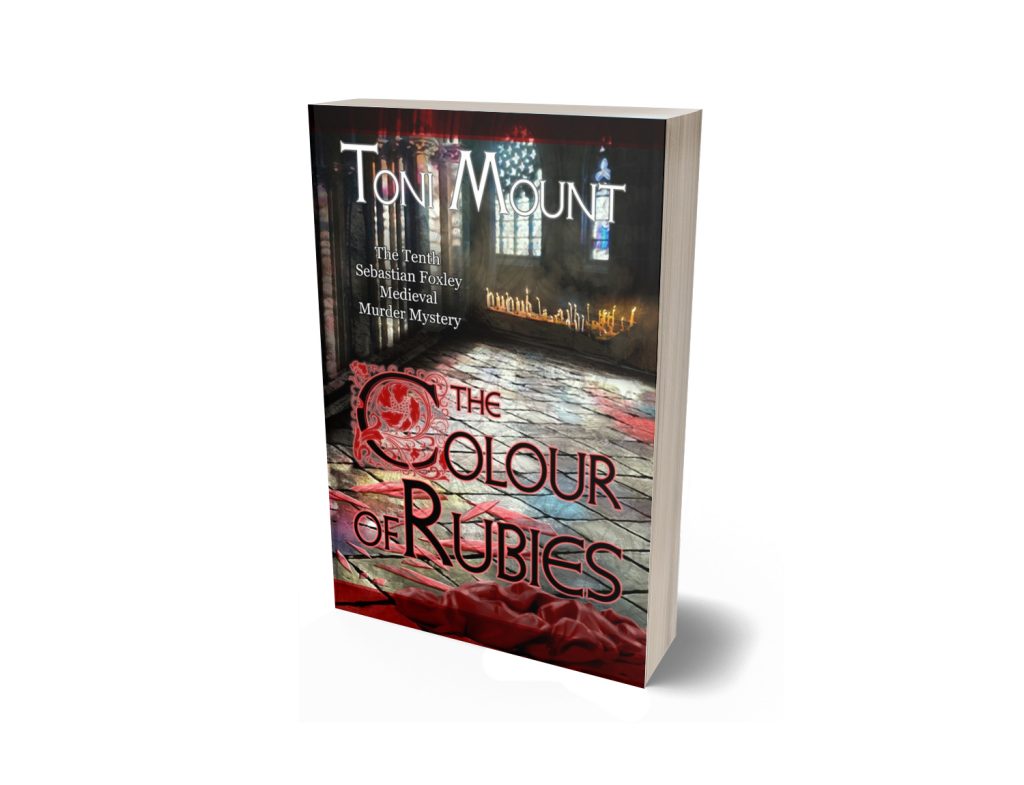
Dame Ellen Langwith in Fact and Fiction
by Toni Mount
Dame Ellen Langton has been a character in my series of Seb Foxley medieval murder mysteries since the beginning. In the first novel, she was Seb and Jude’s landlady and mistress to Emily Appleyard, the love interest. Dame Ellen’s character owes everything to a real silk-woman who also ran a tailoring business in later medieval London, Ellen Langwith.
I discovered Ellen Langwith when I took part in a project for the Richard III Society, transcribing medieval wills, and her will came my way. She died early on in 1481, though the exact date isn’t known, but her fascinating will gives a wealth of information on the life of a woman of some standing in London around that date. Also, I couldn’t resist delving deeper, to find out more about Ellen’s life before she drew up her will. This blog gives you a little of her true story before she became the fictitious Dame Ellen Langton in my novels – I changed her surname ending so it was easier to pronounce.

Ellen probably came from Beckenham in Kent to London, to serve an apprenticeship as a silk-woman sometime in the early fifteenth century. Her first husband, Philip Waltham, was a cutler who also owned a brewhouse, Le Hertishorne’, just outside Newgate. [The Hart’s Horn also appears in my novels as a tavern run by Mistress Fletcher.] Ellen was already a successful silk-woman. In his will of 1425, Philip named his three apprentices: Agnes Walshale, Agnes Sampson and Alice Dunnowe, leaving them 6s 8d each on the condition that they behaved courteously, in both word and deed, towards his wife Ellen, their mistress, at whose discretion the money was to be given. From the wording of the will, it’s impossible to say whether the three girls were apprenticed as cutlers or silk-women. Perhaps they were making high fashion silk scabbards for the knives Philip manufactured. Ellen was a widow by May 1426, the main executor of her husband’s will, sole owner of all his movable goods and the Hartshorn brewery.
By 1437, she had married again. Her second husband was John Langwith, a successful tailor who had become a freeman of the city in 1418 and took on his first apprentices in 1425. Since masters ought to have wives to care for the apprentices, it seems likely John had been married previously before he wed Ellen since, at this time, she was still Philip Waltham’s wife. John was elected master of the Merchant-Taylors’ Company in 1444 and in the summer of 1445 he led the company in the elaborate processions to welcome Margaret of Anjou to London as the bride of King Henry VI. The tailors spent £3 on blue livery gowns for the master and wardens to look their impressive best for the occasion. Could Ellen have supplied any silken trimmings for the robes? We don’t know, but that year she was admitted, free of charge, to the tailors’ Fraternity of St John the Baptist. It was in the chapel of St John the Baptist, in their parish church of St Mary Abcurch, that both John and, later, Ellen would be buried. The Langwiths lived in a tenement on the north side of Candlewick Street, one of a group of properties owned by John, which shared a courtyard.
In 1439, Ellen was one of a group of London silk-women who bought £30 worth of silk from Venetian merchants. In February 1443, she purchased a fardell of silk for herself at the incredible cost of £60 11s 8d, showing how her business had grown. According to the OED, a ‘fardel[l]’ is a bundle of cloth of no fixed size, length or weight, but this one must have been significant and luxurious. Ellen certainly had apprentices, but may also have distributed work to other women to do at home. At this time, another silk-woman, Katherine Dore, was putting out work to women living in Soper Lane.
While John Langwith was training lads as apprentice tailors, one indenture for a girl survives: Elizabeth Eland was taken on in July 1454 by both John and Ellen to train as a silk-woman. She may have joined other girls under Ellen’s tuition; if so, their indentures haven’t survived. We don’t know if Elizabeth completed her apprenticeship or what happened to her. She isn’t mentioned in Ellen’s will, but that’s not surprising since it wasn’t drawn up until 1481, twenty-one years after Elizabeth should have finished her training.
In 1465, Ellen gained royal patronage when she was commissioned to supply silk banners and trappings for the saddle and pillion for Elizabeth Woodville, Edward IV’s queen, for her coronation. Ellen had to deliver the goods ‘into the hands of Thomas Vaughn one of the esquires of our [the king’s] body to the use of our most dear and entirely beloved Queen…’ and was paid £27 10s.
John Langwith died in July 1467 and, like Philip Waltham before him, made Ellen his executrix, leaving her responsible for an ‘estate of lands’ at Beckenham in Kent, which may have been her own inheritance. Ellen was now a very wealthy widow without an heir so she too drew up a will, although she would outlive John by over thirteen years. Her will was artfully worded. She left much of her property to the Taylors’ Company with the proviso that if they failed in its adequate administration, all would be forfeit to the Cutlers. In this way, she was well favoured by both companies, invited to their feasts on special occasions and sent gifts of food and wine to keep them in mind. In 1476, the tailors spent 2s on a pike and wine for Mistress Langwith, while the less wealthy cutlers sent her a rabbit and a hen costing 8d.
In her will, Ellen left 10s to pay for her funeral in St Mary Abchurch, which included money to the parish clerk to ring the bells. There were alms to the poor and the Taylors’ Company was to use money from the rents paid to them from the Langwith properties, to buy twenty-six quarters of coal for thirteen poor men and women of the parish, on the anniversary of Ellen’s death. Before she died – sometime between January and June 1481 – she left an additional, modest will, bequeathing most of her household goods to her current apprentice, John Brown (presumably an apprentice tailor). She left 40s to Richard Wiott, the son of a shearman, when he should come of age, and money and goods to her servants, John England and Emmott Bynchester. The will also notes that John Brown has a sister, unnamed, who is a servant. [These siblings gave rise to Emily and John Appleyard in my novels.]
Otherwise, all Ellen’s bequests were made to women: Margaret, wife of John Wareng, one of her two executors, was to have a gold ring set with a diamond and an image of Our Lady from Ellen’s chamber; Mary, wife of John Jakes the draper, the second executor, was to have her blue silk girdle with silver-gilt decorations and Katherine, wife of Hugh Pemberton, the overseer of Ellen’s will, was to receive a gold ring set with turquoise. A gown of black medley (a wool mixture?), trimmed with white lamb, was left to her cousin Mistress Bowyer of Northampton, and her best blue gown, trimmed with marten fur, was bequeathed to another cousin, Mistress Bounesley of Nottingham. Her personal belongings, household goods and furnishings mentioned in her will, suggest Ellen was a prosperous and dignified elderly woman who had had a very successful career, whether as the wife of a cutler and a tailor or as a craftswoman in her own right.
In my new Seb Foxley adventure, The Colour of Rubies, set in 1480, Dame Ellen Langton remains a close and respected friend of the family though becoming rather frail these days and I owe her existence to that chance encounter during the project for the Richard III Society some years ago. For the transcript of her will and all the contemporary wills in the Logge Register PCC see the society’s publication: The Logge Register of PCC Wills, 1479-86, 2008. If you want to join Seb, his family and friends on their exploits in medieval London and Westminster, stealing down dark alleyways, waiting nervously in opulent chambers and freezing their fingers off in the icy scriptorium where a murderer lurks, I’m afraid you’ll have to read the book: The Colour of Rubies, by Toni Mount, published 5th May 2022.

Toni Mount is the author of several successful non-fiction books including How to Survive in Medieval England and the number one best-seller, Everyday Life in Medieval England. Her specialty is the lives of ordinary people in the Middle Ages and her enthusiastic understanding of the period allows her to create accurate, atmospheric settings and realistic characters for her medieval mysteries. Her main character, Sebastian Foxley is a humble but talented medieval artist and was created as a project as part of her university diploma in creative writing. Toni earned her history BA from The Open University and her Master’s Degree from the University of Kent by completing original research into a unique 15th century medical manuscript. Toni writes regularly for both The Richard III Society and The Tudor Society and is a major contributor to MedievalCourses.com. As well as writing, Toni teaches history to adults, and is a popular speaker to groups and societies.


Murder lurks at the heart of the royal court in the rabbit warren of the Palace of Westminster. The year is 1480. Treason is afoot amongst the squalid grandeur and opulent filth of this medieval world of contrasts. Even the Office of the King’s Secretary hides a dangerous secret.
Meeting with lords and lackeys, clerks, courtiers and the mighty King Edward himself, can Seb Foxley decipher the encoded messages and name the spy?
Will Seb be able to prevent the murder of the most important heir in England?
All will be revealed as we join Seb Foxley and his abrasive brother Jude in the latest intriguing adventure amid the sordid shadows of fifteenth-century London.
Praise for Toni Mount’s Sebastian Foxley Medieval Murder Series
Tracy Borman, historian and broadcaster“An atmospheric and compelling thriller that takes the reader to the dark heart of medieval London.”
Matthew Lewis author of Richard III Loyalty Binds Me “Toni Mount continues to delight with the superbly crafted Seb Foxley mysteries. Impeccable research and sculpted characters combine with an engaging narrative to create another irresistible story. This series goes from strength to strength, and I’m already looking forward to the next instalment”
J.P. Reedman, author of the I, RICHARD PLANTAGENET series: “Sebastian Foxley is the Cadfael of the 15th century”.
“The Sebastian Foxley Medieval Mystery Series by Toni Mount is not only filled by dastardly murders and gripping intrigue but contains many well-researched historical facts from the Wars of the Roses era”
Samantha Willcoxson, author & historian “Toni Mount is simply brilliant”.
“If you love CJ Sansom’s Matthew Shardlake (and I do) you will love Toni’s Sebastian Foxley”.
“From learning how a 15th century scrivener created illuminated manuscripts to venturing within the dank tunnels beneath the Tower of London, Toni is an artist who completely immerses the reader in another time and place and always leaves one eager for the next book.”
Stephanie Churchill, author of historical fiction and epic fantasy “Leave it to Seb to unravel another international spiderweb of intrigue, betrayal, murder, and deceit. Our flawed, loveable hero has done it again. And at the end of it all, his future is looking brighter than ever. I cannot wait to find out what happens to him next!”
Sharon Bennet Connoly, author and medieval historian“A beautifully crafted mystery that brings the dark, dangerous streets of medieval London to life. Toni Mount is a magician with words, weaving a captivating story in wonderful prose. The Colour of Evil is, to put it simply, a pleasure to read.”
Rosalie Gilbert, medieval historian and author “The author’s knowledge of medieval history shines through the narrative in the small details which enhance the story woven into it. The details about the inside workings of medieval trade practices lent themselves perfectly for a background to murder and deceit”.
“Recommended for lovers of historic fiction.”
Joanne R Larner author of Richard Liveth Yet trilogy: “I always look forward to a new ‘Colour of…’ book. I can’t wait to see what escapades Seb Foxley and his brother, Jude, get up to next. They, and all the characters, are endearing and colourful. The books are always well written, conjuring 15th century London into the reader’s mind and the plots are excellent!’
Mel Starr bestselling author of the Hugh de Singleton chronicles: “If I believed in reincarnation I would be willing to think that Toni Mount lived a previous life in 15th century London. The scents, the sights, the tastes of the late Middle Ages are superbly rendered.”





2 Comments
Sue the Silkewoman
I love the amount of detail in existence regarding Ellen (and Alice Claver, of course!)
Have you come across any further information, (other than from Soper Lane, Caroline Barron, Annie Sutton, Marion Dale and Sharon Farmer) on Beatrice Fyler, Elizabeth Stockton, Katherine Hardman, Elizabeth Eland and Alice Arnold by any chance?
toni mount
Hi Sue – great to meet you – I think you have covered all the bases and I don’t know of any other sources except the Richard III Society’s ‘Wills from the Logge Register PCC’ published in 2008 which has Ellen Langwith’s will transcribed and my research done on her at the time. Caroline Barron used my later research in one of her books based on a lecture she gave using some of my material for which she credited me but I can’t recall the title and you have probably read it anyway.
The only other source of info I have on the silk business is the V&A’s exhibition catalogue book ‘English Medieval Embroidery’ which has quite a bit about silk imports etc. but mentions no names of silk women in the catalogue although Alice Claver was named as part of the exhibition. It’s a gorgeous book published by Yale University in 2016. When you mention Annie Sutton, do you mean Anne Sutton of the RIII Society? (I’ve not heard anyone call her Annie before).
We are due to be at the Sandwich Medieval centre on June 12 so may be we will meet? Sorry I can’t be more help.
BW Toni